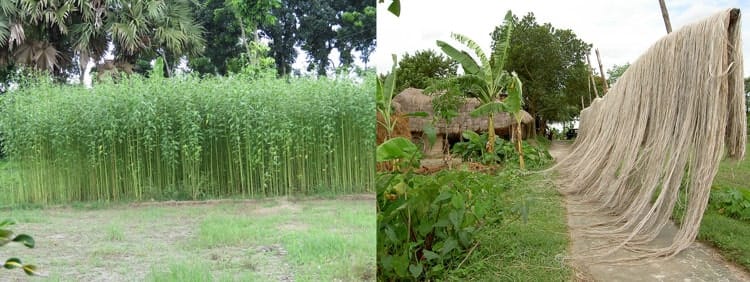When looking for sustainable materials, jute tops the list of many environmentalists. This is because jute fabric has many benefits. Apart from being eco-friendly, jute is extremely durable and can hold up to some serious wear and tear. But what is Jute exactly? Read on to find out the different types of jute and how they’re converted from fiber to product.
What Is Jute?
Jute, also known as “the golden fiber”, is a long, soft, and shiny fiber derived from the jute plant. Inexpensive and durable, jute is second only to cotton in terms of popularity. It’s commonly used to make curtains, rugs, sacks, and ropes. But, did you know it’s employed to create fashionable garments too? Bags, shoes, and fashion accessories can all be made with jute. Jute is often combined with cotton and other natural fibers to make the final product soft, light, and breathable.

Applications Of Jute
Jute has widespread popularity due to its endless applications. The versatile fiber can be used independently or blended with a range of materials. As jute is soft to the touch, it is often used to make a wide range of lifestyle consumer products. Whether round, square, or rectangular, jute’s natural look brings warmth to any environment.
Handlooms and factories use jute to spin and weave high-quality yarns into fine-textured fabrics. This results in gorgeous colors and designs. When jute is bleached, dyed, and finished, the result is a better feel, sheen, resistance to grazing, and artistic appeal.
Jute holds an important place in sustainable fashion. Listed below are some modern applications of jute.
1. Apparel And Bags
Jute is becoming more popular among high-end designers because of its eco-friendly benefit and visual appeal. Modern ways to process jute are also making it easier to acquire. Designers have found ways to incorporate jute into jackets, cardigans, sweaters and more.
However, jute clothing may not be everyone’s style. But that doesn’t mean it can’t come in handy. Jute bags are a great addition to our wardrobes. They’re perfect for grocery runs, shopping, and even beach events. Using jute bags as a promotional item is a great way to include your customers in your eco-friendly jounrey. If you intend to buy such bags in bulk, take a look at AvecoBaggie’s versatile collection of bags. From totes to backpacks, we have something for everyone.

2. Crafts
Jute is also a popular material for crafts and creative projects. This textured fabric is often wrapped around coasters and planters. From living room decor to wedding favors, jute is the perfect fabric for a boho vibe.

3. Furniture
The making of furniture, chair covers, rugs, curtains, and other things involves jute. It’s natural look and texture bring a fresh personality to homes.
Using jute bags as a promotional item? Equip your store with jute furniture and coverings to match the mood.
Types Of Jute
Several kinds of jute fabrics exist. However, there are only three kinds that are suitable enough to make fabric. These are:
1. White Jute
The Malvaceae family includes the shrub species Corchorus capsular, which is also found in the Brazilian Amazon. It’s one of the places to get jute fiber, and its quality is supposedly higher than that of the primary jute plant. White jute is lighter in color than other strains of this fiber, but it is also less durable than other jutes
2. Tossa Jute
Corchorus olitorius, often known as tosa jute, is a traditional South Asian fiber. In comparison to white jute, Tosa jute fiber is softer, silkier, and more durable. This is why it’s used a lot in the packaging and textile industries. Tossa jute acts as a great packager because it keeps things warm, and can absorb a moderate amount of water.

3. Mesta Jute
Mesta jute comes from crossing white jute with Tossa jute. This Afro-Asian crop is a type of natural fiber that can manufacture yarns and fabrics. The stem or bark of the mesta plant makes fiber. Like all natural materials, the fibre yield and quality of this type of jute depends on the stage of harvesting.
Jute Processing Steps
To get from plant to fabric, jute goes through a long, complicated process. Let’s dive deeper into how these steps carry out and give us the end-product we need.
1. Selection
After the raw jute has dried, it then turn into jellies in the shape of 150 kg or 180 kg bells so that it is easy to move. The bells from the mill’s storage area now move to the selection department. Here, experienced workers open the jute bells to look for jute and remove the broken parts from the bend.
2. Batching
The process of batching is to mix oil and water in jute. The part that gets the jute ready for carding is the batching house. In this segment, oil and water are added to the fibers to make them easier to work on in the next steps.
3. Batching Emulsion
Mineral oil, water, and an emulsifier are often the three main components of a jute batching emulsion. Most of the time, people use Jute Batching Oil (JBO), which is a medium distillate made by oil refineries. JBO makes the fiber smooth and bendy by lubricating it. Water gives the fiber the right amount of moisture and makes it stretchier. The emulsifier lowers the surface tension and keeps the emulsion from breaking apart.
4. Softening
The softener machine helps to group together sucking yarns. It is of low-quality raw materials. It is a long machine with 4-2 curved rollers made of cast iron. After getting soft, long jute is conditioned for 24 to 48 hours before it is ready for the breaker card.
5. Carding
The main goals of carding jute are-
- Open the tuft of fibres and make it parallel and straight.
- Cutting the jute root in half, lengthwise and across.
- Turning jute hats into uniform strands of fiber for further processing.
6. Drafting
The main objective of drafting is to:
- Improve the fiber arrangement in the silver and make fibres parallel to the length of silver.
- Double the slivers to cut down on any faults that may arise.
- Straighten the hooked, curled, and crimped fibres present in the silver.
7. Spinning
Most of the jute yarn comes from the finisher drawing sliver, and spinning from the rove is mostly limited to the finer range. Today, though, ring spinning is mostly used to make fine-count yarn right from the sliver. The frame for spinning jute is Known as a “pitch” because of the distance between the spindles. The main goals of spinning are to draught, twist, and turn.

Conclusion
With jute bags growing in popularity, you might not want to miss out on the fun. In search of customized jute bag manufacturer that showcase your environmental-friendly brand? Then head over to AvecoBaggie to pick the texture, dimensions, pattern, and colors. You can also add a personal touch with your brand’s logo, slogans, or fun prints that represent you as a brand.
We hope this article brings you enough information to help you identify the many ways you can use jute fiber to help grow your business. For more information about AvecoBaggie fabrics and processes, visit our blogs section.


